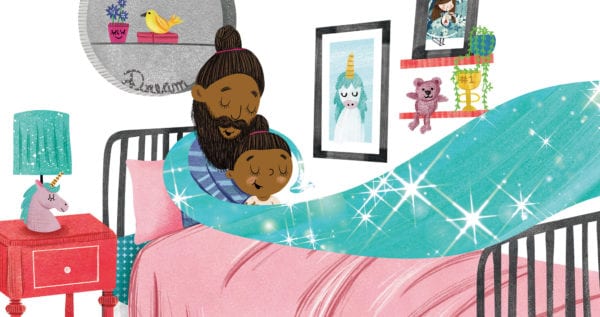
Award-winning author Raakhee Mirchandani and New York Times bestselling illustrator Holly Hatam join forces for Hair Twins (Little, Brown Books for Young Readers, Ages 4–8). This charming picture book celebrates the unique hair bond between a Sikh father and his daughter. Digitally rendered illustrations by Hatam capture the daughter’s joy when she and her dad achieve the titular twinning. Hatam spoke with Q&Q about Hair Twins, diversity in children’s books, and the importance of joyful representation.
What was your first reaction to reading the manuscript of Hair Twins?
I cried, then laughed, then cried some more!
What was your approach to the project?
Mirchandani sent me pictures and videos of how to properly wrap a turban. I also did my own research. I wanted the illustrations to not only be joyful but to appropriately and respectfully represent the beautiful Sikh tradition.
How important is diversity in children’s books to you?
Diversity and kindness in books are the guiding forces of my work. Growing up in the ’80s, in a small town in Canada, I instantly knew I was different. Not only did I feel invisible at school, but also when reading books and watching TV. I never saw myself in the characters, which made me feel unimportant. I felt ugly – always wishing I could change the way I look. I was ashamed and embarrassed of being Iranian and hid a lot of myself. I stayed quiet and tried to blend in as much as I could. I became an extremely shy kid, who turned into an adult with anxiety. That anxiety is amplified because of the colour of my skin. I’ve lived in Canada almost my whole life, but I still don’t feel fully welcome.
As an artist, I’ve dedicated myself to spreading kindness and to being the voice for all kids and adults who have had to hide themselves in the shadows. Now as a mom of a biracial son, my mission to create diverse books is that much more important. I don’t want him to feel as I did growing up. I want him to be proud of who he is and where he comes from.
What response have you received from readers?
I’ve had parents message me and tell me the illustrations made them cry because they reminded them of their childhoods, watching their dads wrap their turbans. I’ve had parents thank me for capturing their traditions with such joy.
What does joyful representation mean to you?
It means giving readers a glimpse into someone else’s story to create acceptance and kindness. Diverse books are not only important for people of colour, but for all people. All cultures should be given the opportunity to celebrate their traditions and share their stories with the world. We all have something beautiful to share.
 Contact us via email
Contact us via email

